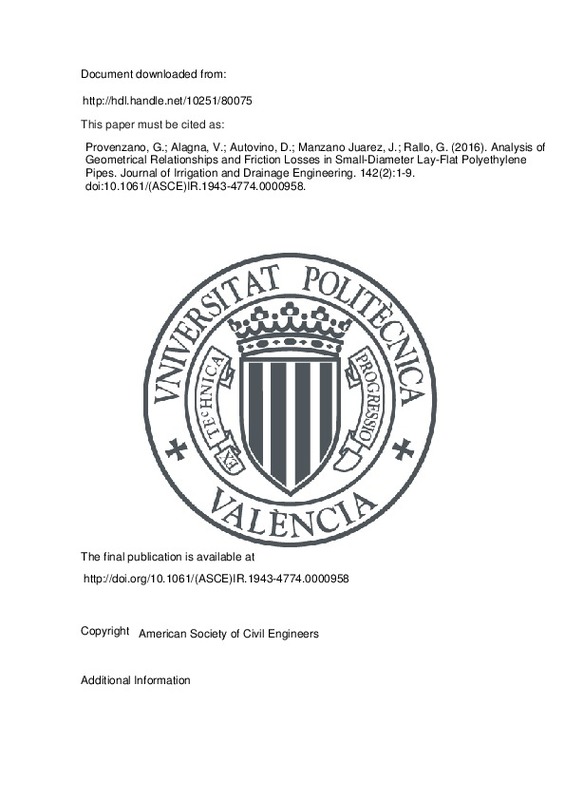JavaScript is disabled for your browser. Some features of this site may not work without it.
Buscar en RiuNet
Listar
Mi cuenta
Estadísticas
Ayuda RiuNet
Admin. UPV
Analysis of Geometrical Relationships and Friction Losses in Small-Diameter Lay-Flat Polyethylene Pipes
Mostrar el registro sencillo del ítem
Ficheros en el ítem
| dc.contributor.author | Provenzano, Giuseppe
|
es_ES |
| dc.contributor.author | Alagna, Vincenzo
|
es_ES |
| dc.contributor.author | Autovino, Dario
|
es_ES |
| dc.contributor.author | Manzano Juarez, Juan
|
es_ES |
| dc.contributor.author | Rallo, Giovanni
|
es_ES |
| dc.date.accessioned | 2017-04-27T06:24:46Z | |
| dc.date.available | 2017-04-27T06:24:46Z | |
| dc.date.issued | 2016-02 | |
| dc.identifier.issn | 0733-9437 | |
| dc.identifier.uri | http://hdl.handle.net/10251/80075 | |
| dc.description.abstract | [EN] The use of lay-flat polyethylene pipes to irrigate horticultural crops has been receiving widespread attention in the last decade, due to the significant improvements in their hydraulic performance, their potentially high application efficiency, and their limited installation costs. However, even if hydraulic design procedures for conventional microirrigation systems are fairly well established, there is still the need to know how different pipe-wall thicknesses of lay-flat pipes can affect the pipe geometry under different operating pressures as well as the related consequences on friction losses. This paper, after comparing two different procedures (caliper and photographic) to assess the geometry of lay-flat polyethylene pipes under different operating pressures, analyzes the friction losses per unit of pipe length, J, in order to identify and to assess a procedure for their evaluation. Hydrostatic tests, initially carried out on pipes with wall thicknesses of 6, 8, and 10 thousandth of an inch (mil), evidenced that the pipe dimensions measured with both methods are quite similar, despite the generally higher standard deviations characterizing caliper measurements when compared to photographic method. Tests allowed to verify that most of the changes in pipe dimensions occur within a range of pressure from 0 kPa to about 30 kPa, with pipe horizontal width and vertical height quite similar at higher pressures and pipes have a tendency to become circular. Additionally, due to the elasticity of the material, over a certain limit of water pressure, both the pipe dimensions tend to rise, with a trend depending on pipe thickness. According to the experimental data, the relationships between pipe effective diameter and water pressure were then determined for the three considered pipes. Moreover, based on measured friction losses and pipe effective diameters, it was confirmed that the relationship between the Darcy-Weisbach friction factor, f, and the Reynolds number, R, can be described by a power equation in which, by assuming a value of -0.25 for the exponent, it results a coefficient c = 0.285, lower than the theoretical. For the three investigated pipes the errors associated to estimated J were finally evaluated by considering (1) the experimental relationships between friction factor and Reynolds number as well as between pipe diameter and operating pressure (Case A); (2) the same value of c, but pipe effective diameters of 16.20, 16.10, and 15.85 mm corresponding to p = p(lim) (Case B); (3) the standard procedure, with a value of c = 0.302 and the pipe diameter equal to 16.10 mm, as suggested by the manufacturer. The results evidenced that suitable estimations of J need to account for the variations of the pipe effective diameter with water pressure. On the other hand, incorrect values of pipe diameter combined with inexact values of the friction factor generate inaccurate estimations of friction losses, with unavoidable consequences in pipe design. (C) 2015 American Society of Civil Engineers. | es_ES |
| dc.description.sponsorship | The research was cofinanced by Universita di Palermo (FFR 2011) and Ministero dell'Istruzione, dell'Universita e della Ricerca (PRIN 2010). All the authors setup the research and discussed the results. V. Alagna and D. Autovino carried out the experimental measurements and G. Provenzano wrote the paper. A special thank to the Committee for International Relations Office (CORI) of University of Palermo to support the research cooperation with the University of Valencia. | en_EN |
| dc.language | Inglés | es_ES |
| dc.publisher | American Society of Civil Engineers | es_ES |
| dc.relation.ispartof | Journal of Irrigation and Drainage Engineering | es_ES |
| dc.rights | Reserva de todos los derechos | es_ES |
| dc.subject | Lay-flat polyethylene pipes | es_ES |
| dc.subject | Pipe geometry | es_ES |
| dc.subject | Hydraulic radius | es_ES |
| dc.subject | Friction losses | es_ES |
| dc.subject | Friction factor | es_ES |
| dc.subject.classification | INGENIERIA AGROFORESTAL | es_ES |
| dc.title | Analysis of Geometrical Relationships and Friction Losses in Small-Diameter Lay-Flat Polyethylene Pipes | es_ES |
| dc.type | Artículo | es_ES |
| dc.identifier.doi | 10.1061/(ASCE)IR.1943-4774.0000958 | |
| dc.relation.projectID | info:eu-repo/grantAgreement/Università degli Studi di Palermo//FFR 2011/ | es_ES |
| dc.rights.accessRights | Abierto | es_ES |
| dc.contributor.affiliation | Universitat Politècnica de València. Departamento de Ingeniería Rural y Agroalimentaria - Departament d'Enginyeria Rural i Agroalimentària | es_ES |
| dc.contributor.affiliation | Universitat Politècnica de València. Escuela Técnica Superior de Ingeniería Agronómica y del Medio Natural - Escola Tècnica Superior d'Enginyeria Agronòmica i del Medi Natural | es_ES |
| dc.description.bibliographicCitation | Provenzano, G.; Alagna, V.; Autovino, D.; Manzano Juarez, J.; Rallo, G. (2016). Analysis of Geometrical Relationships and Friction Losses in Small-Diameter Lay-Flat Polyethylene Pipes. Journal of Irrigation and Drainage Engineering. 142(2):1-9. https://doi.org/10.1061/(ASCE)IR.1943-4774.0000958 | es_ES |
| dc.description.accrualMethod | S | es_ES |
| dc.relation.publisherversion | http://doi.org/10.1061/(ASCE)IR.1943-4774.0000958 | es_ES |
| dc.description.upvformatpinicio | 1 | es_ES |
| dc.description.upvformatpfin | 9 | es_ES |
| dc.type.version | info:eu-repo/semantics/publishedVersion | es_ES |
| dc.description.volume | 142 | es_ES |
| dc.description.issue | 2 | es_ES |
| dc.relation.senia | 295122 | es_ES |
| dc.identifier.eissn | 1943-4774 | |
| dc.contributor.funder | Università degli Studi di Palermo | es_ES |
| dc.contributor.funder | Ministero dell'Istruzione dell'Università e della Ricerca, Italia | es_ES |







![[Cerrado]](/themes/UPV/images/candado.png)

